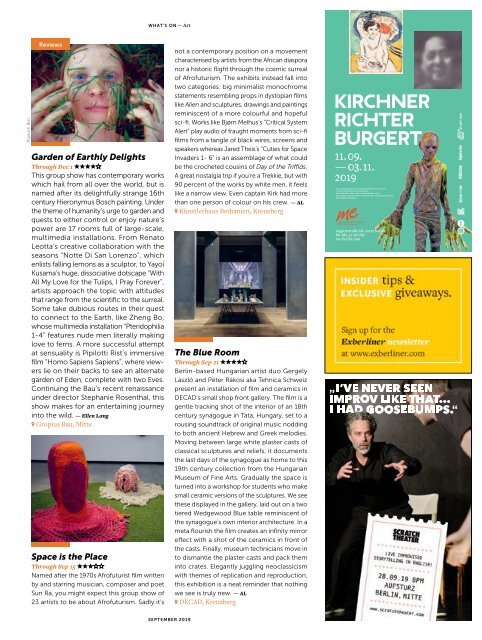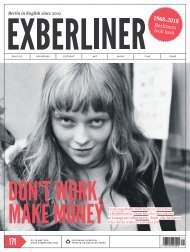Exberliner issue 185, September 2019
- No tags were found...
You also want an ePaper? Increase the reach of your titles
YUMPU automatically turns print PDFs into web optimized ePapers that Google loves.
WHAT’S ON — Art<br />
Pipilotti Rist<br />
Reviews<br />
Garden of Earthly Delights<br />
Through Dec 1<br />
This group show has contemporary works<br />
which hail from all over the world, but is<br />
named after its delightfully strange 16th<br />
century Hieronymus Bosch painting. Under<br />
the theme of humanity’s urge to garden and<br />
quests to either control or enjoy nature’s<br />
power are 17 rooms full of large-scale,<br />
multimedia installations. From Renato<br />
Leotta’s creative collaboration with the<br />
seasons “Notte Di San Lorenzo”, which<br />
enlists falling lemons as a sculptor, to Yayoi<br />
Kusama’s huge, dissociative dotscape “With<br />
All My Love for the Tulips, I Pray Forever”,<br />
artists approach the topic with attitudes<br />
that range from the scientific to the surreal.<br />
Some take dubious routes in their quest<br />
to connect to the Earth, like Zheng Bo,<br />
whose multimedia installation “Pteridophilia<br />
1-4” features nude men literally making<br />
love to ferns. A more successful attempt<br />
at sensuality is Pipilotti Rist’s immersive<br />
film “Homo Sapiens Sapiens”, where viewers<br />
lie on their backs to see an alternate<br />
garden of Eden, complete with two Eves.<br />
Continuing the Bau’s recent renaissance<br />
under director Stephanie Rosenthal, this<br />
show makes for an entertaining journey<br />
into the wild. — Ellen Lang<br />
Gropius Bau, Mitte<br />
Space is the Place<br />
Through Sep 15<br />
Named after the 1970s Afrofuturist film written<br />
by and starring musician, composer and poet<br />
Sun Ra, you might expect this group show of<br />
23 artists to be about Afrofuturism. Sadly it’s<br />
not a contemporary position on a movement<br />
characterised by artists from the African diaspora<br />
nor a historic flight through the cosmic surreal<br />
of Afrofuturism. The exhibits instead fall into<br />
two categories: big minimalist monochrome<br />
statements resembling props in dystopian films<br />
like Alien and sculptures, drawings and paintings<br />
reminiscent of a more colourful and hopeful<br />
sci-fi. Works like Bjørn Melhus’s “Critical System<br />
Alert” play audio of fraught moments from sci-fi<br />
films from a tangle of black wires, screens and<br />
speakers whereas Jared Theis’s “Cuties for Space<br />
Invaders 1- 6” is an assemblage of what could<br />
be the crocheted cousins of Day of the Triffids.<br />
A great nostalgia trip if you’re a Trekkie, but with<br />
90 percent of the works by white men, it feels<br />
like a narrow view. Even captain Kirk had more<br />
than one person of colour on his crew. — AL<br />
Künstlerhaus Bethanien, Kreuzberg<br />
The Blue Room<br />
Through Sep 21<br />
Berlin-based Hungarian artist duo Gergely<br />
László and Péter Rákosi aka Tehnica Schweiz<br />
present an installation of film and ceramics in<br />
DECAD’s small shop front gallery. The film is a<br />
gentle tracking shot of the interior of an 18th<br />
century synagogue in Tata, Hungary, set to a<br />
rousing soundtrack of original music nodding<br />
to both ancient Hebrew and Greek melodies.<br />
Moving between large white plaster casts of<br />
classical sculptures and reliefs, it documents<br />
the last days of the synagogue as home to this<br />
19th century collection from the Hungarian<br />
Museum of Fine Arts. Gradually the space is<br />
turned into a workshop for students who make<br />
small ceramic versions of the sculptures. We see<br />
these displayed in the gallery, laid out on a two<br />
tiered Wedgewood Blue table reminiscent of<br />
the synagogue’s own interior architecture. In a<br />
meta flourish the film creates an infinity mirror<br />
effect with a shot of the ceramics in front of<br />
the casts. Finally, museum technicians move in<br />
to dismantle the plaster casts and pack them<br />
into crates. Elegantly juggling neoclassicism<br />
with themes of replication and reproduction,<br />
this exhibition is a neat reminder that nothing<br />
we see is truly new. — AL<br />
DECAD, Kreuzberg<br />
Kirchner<br />
Richter<br />
Burgert<br />
11. 09.<br />
— 03. 11.<br />
<strong>2019</strong><br />
Ernst Ludwig Kirchner, Dodo mit japanischem Schirm, 1909<br />
© Olbricht Collection, Photo Jana Ebert /<br />
Gerhard Richter, Mao, 1968 © Gerhard Richter, <strong>2019</strong> /<br />
Jonas Burgert, Streiter, 2009 © Courtesy of the artist & Blain | Southern,<br />
Photo Lepkowski Studios<br />
Auguststraße 68, 10117 Berlin<br />
Mi-Mo, 12-18 Uhr<br />
me-berlin.com<br />
„I‘VE NEVER SEEN<br />
IMPROV LIKE THAT...<br />
I HAD GOOSEBUMPS.“<br />
Herb Greene<br />
Media partner<br />
Berlin in English since 2002<br />
SEPTEMBER <strong>2019</strong><br />
37


















